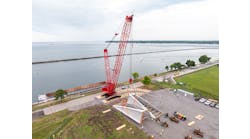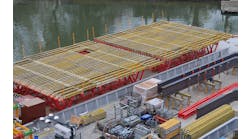By: Jennifer G. Prokopy
During the past 10 years, the design and use of high-performance concrete (HPC) has become more common, with hundreds of structures created using the material. Signature bridges, including the Confederation Bridge in Prince Edward Island, Canada, and the Sagadahoc Bridge in Maine, often are made possible with HPC.
Increased use of HPC grows from the coordinated efforts of individuals and organizations to research and develop the best high-performance solutions throughout the country. Groups like the National Concrete Bridge Council (NCBC) are joining with other industry associations and the Federal Highway Administration (FHWA) to provide technical assistance to states and to secure more funding sources, especially in anticipation of TEA-21 reauthorization. The benefits of HPC for bridges make it attractive for projects large and small.
Backing the popular demand
The cost savings associated with HPC makes bridge construction with the technique a good long-term decision, said Shri Bhide, chairman of the NCBC and manager of the Portland Cement Association's (PCA) bridge program. "HPC bridges have minimal maintenance needs," said Bhide, "and the lifespan of HPC bridges is typically twice that of conventionally built bridges."
HPC makes it possible to create longer components for the bridges, reducing the number of piers in water and adjacent to roadways, resulting in lower foundation costs and improved safety. It reduces the number of expansion joints and bearings and the subsequent need for repair and replacement. HPC also lends itself to use of precast/prestressed elements, which reduce construction time and labor costs. "HPC ties in very well with FHWA's emphasis on reducing congestion through accelerated construction techniques," said Lou Triandafilou, P.E., high-performance structural materials specialist for FHWA's Resource Center in Baltimore.
The durability of HPC makes it equally attractive. HPC bridges are typically designed for 100 years of service life, and advances in testing and mix design allow designers to create concrete that resists corrosion in the harshest environments.
Helping the deficient
A prime motivator for increased use of HPC in bridge building is the high number of deficient bridges in the U.S. According to 2002 National Bridge Inventory data, one in four bridges is structurally deficient or functionally obsolete. The NCBC and FHWA believe HPC usage can reduce the number of deficient bridges and create a more lasting infrastructure.
"The FHWA's goal is to get in front of the bridge deterioration curve and stay there," said Bhide.
Perhaps the biggest challenge, agreed Bhide and Triandafilou, is to get state DOTs comfortable with the method.
DOTs often hesitate to use new technology, said Triandafilou: "When it comes to HPC, putting that first foot forward and taking steps is a challenge."
To that end, FHWA is identifying states with potential for growth in HPC use and working personally with their administrations to speed the process. Partnerships with the concrete industry in those states smooth the way, and Bhide said the NCBC and state organizations have plans to hold workshops, introduce courses at universities and develop certification programs to further FHWA's efforts.
So far, the result is a rapid increase in HPC bridge construction activity. In the last five years, under TEA-21's Innovative Bridge Research and Construction (IBRC) Program, 40 HPC bridges were constructed using the cast-in-place bridge deck method and 20 HPC bridges were built using prestressed concrete girder superstructures. HPC substructures and foundations were funded on 10 additional bridges. States leading the pack include New York, New Hampshire, Virginia, Ohio, Washington and Florida.
More super strength
At the Turner-Fairbank Highway Research Center in McLean, Va., the FHWA is researching what Triandafilou called "the next generation" in HPC: ultra high-performance concrete. Capable of strengths more than double that of typical HPC, the material uses prestressing strands but requires no conventional reinforcing, relying on steel and polypropylene structural fibers in the concrete mix.
"Because of the higher strength of this material, we can look at new shapes of girders that take the best advantage of its higher strength," said Triandafilou. Additional research is focused on creating HPC with lightweight aggregates and on self-consolidating concrete, which is gaining popularity among North American precasters based on experiences abroad.
The concrete itself is only a small piece of the puzzle, said Triandafilou. For HPC bridges to become truly mainstream, he said, "there is a learning curve, both for materials and for construction, placement, handling and curing, and that comes back to working with local industry and getting people comfortable with using it." To increase dialogue, the FHWA created the HPC exchange (know-ledge.fhwa.dot.gov/cops/hpcx.nsf/home).
With TEA-21 reauthorization still up in the air, the industry is hesitant to put a number on predictions for the future of HPC bridges. Nineteen HPC projects were submitted for review and approval under the last year of the IBRC Program, and Triandafilou said many states will embrace the technique no matter what level of funding is available. The FHWA and NCBC both consider the construction of HPC bridges in every state a key goal.
Examples of successful training in the U.S. are:
Wacker Drive Reconstruction--
Chicago
High-performance concrete played a key role in reviving Chicago's Wacker Drive, a main artery through the heart of the city's downtown area. First completed in 1926, the drive in recent years has served as many as 75,000 automobiles a day on its upper and lower levels, not to mention more than 100,000 cars that cross it daily on intersecting streets and bridges. After 75 years of service, the drive was severely deteriorated when the Wacker Drive Viaduct Reconstruction Project began in October 2001.
Wiss, Janney, Elstner Associates Inc., Northbrook, Ill., developed an HPC mix that would resist chloride penetration, achieve appropriately high compressive strengths and work well in both post-tensioned segmental and traditional cast-in-place construction. A quaternary mix--incorporating low-alkali cement, class F fly ash, silica fume and ground granulated blast furnace slag--provided concrete that could stand up to Chicago's vacillating freeze-thaw cycles and aggressive wintertime salting program, while providing workability in areas of congested reinforcing steel and post-tensioning ducts and anchors.
Tim Schmidt, construction manager for Alfred Benesch & Co., helped oversee the work of contractors and resident engineers hired by the Chicago Department of Transportation on the project. Schmidt said that while "the HPC used on the project possessed many good qualities," controlling air contents was a challenge that required aggressive quality control and assurance efforts.
Virginia Dare Memorial Bridge--Manteo, N.C.
Located on U.S. 64/264 over the Croatan Sound at Manteo, the Virginia Dare Memorial Bridge is the longest bridge in North Carolina, connecting the mainland to Roanoke Island. The bridge is on a hurricane evacuation route in a highly corrosive coastal environment, and design had to accommodate high-level navigable clearances, vessel impact forces and coastal storm surge and scour characteristics. With allowances for nearby environmentally sensitive wetlands further complicating the situation, the design team had a lot of challenges to tackle.
In a unique design partnership, Wilbur Smith Associates provided structural design, working with the North Carolina Department of Transportation's plan for durability. Rodger D. Rochelle, state research engineer with NCDOT, led a research group that used Fick's Second Law of Diffusion to model diffusion of chlorides and determine the best HPC mix design for every bridge component, ensuring 100 years of service life for the entire structure.
"Designing for durability is a rather new concept," said Rochelle. The model examines input parameters that take into account the quality of the concrete, the amount of concrete cover over reinforcing steel and how much chloride exposure each structural element will experience. For each major component, the law was applied and a mix was designed. After running between 300 and 400 permutations, the team evaluated constructability of a narrowed field of choices and determined the best approach for each component.
The NCDOT team started a new research project in July 2003 that will measure chloride exposures in core samples of existing bridges throughout the state, using the data to apply the model even more accurately on future projects.
About The Author: Prokopy is a freelance writer based in Chicago, Ill.


